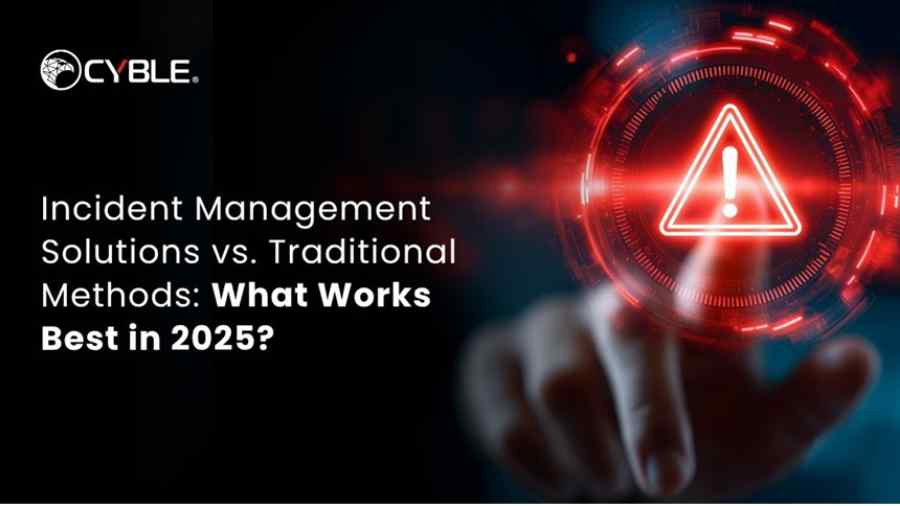Incident Management Solutions vs. Traditional Methods: What Works Best in 2025?

We are staring at the end of 2025 already and planning for the next year. But 2025 still holds its value as it saw the cybersecurity industry at its peak with various security solutions carving a new path for the next generation of security. But the question that remains is: are traditional incident management methods still effective, or have modern incident management solutions rendered them obsolete?
In 2025, the stakes are so high that businesses that do not adopt the next generation of security practices will be left behind. In the last few years also, businesses have been operating in a place where downtime, even for a few minutes, can cost millions. Adding to that, cyber threats have evolved, and disruptions can affect not just revenue but also public trust and regulatory compliance. Against this backdrop, incident management in 2025 is no longer optional—it’s a strategic necessity.
Traditional Incident Management Methods: Are They Still Viable?
Traditional incident management methods typically rely on manual processes—such as email chains, phone calls, spreadsheets, and human triage to resolve incidents. These approaches, while once effective, now struggle to keep up with the speed and scale of modern IT environments.
In traditional frameworks, when an incident occurs (like a system crash or security breach), the process often looks like this:
- A user reports an issue via helpdesk or email.
- The IT team investigates, usually without a centralized log.
- Cross-team communication happens informally.
- Resolution is reactive, often slow, and inconsistent.
- Documentation, if any, occurs after-the-fact.
This approach leads to delays, information silos, and in many cases, unresolved root causes.
Enter Modern Incident Management Solutions
In contrast, incident management solutions in 2025 offer a far more agile, proactive, and intelligent approach. Platforms like Cyble’s Incident Management module integrate automation, real-time analytics, and centralized communication to help teams detect, triage, and respond to incidents more efficiently.
These modern incident response tools offer key capabilities such as:
- Automated alerting and ticketing based on real-time monitoring.
- Incident grouping to reduce alert fatigue and streamline triage.
- Customizable dashboards for tracking incidents in real time.
- Role-based access control for secure collaboration.
- Audit logging to ensure compliance and post-incident review accuracy.
By leveraging AI and machine learning, these tools can also predict potential incidents, prioritize threats based on business impact, and reduce manual workloads dramatically.
The ITIL Framework Still Matters—But Needs Modernization
The ITIL (Information Technology Infrastructure Library) framework continues to underpin many incidents management in 2025 strategies. It provides a structured process that includes incident detection, classification, diagnosis, resolution, and closure. However, organizations are increasingly integrating modern incident response tools within the ITIL framework to enable faster, more intelligent action.
An example: where ITIL recommends categorizing and prioritizing incidents, automated platforms now do this instantly, using real-time data. This eliminates the delay of manual triage and ensures that critical incidents, like a ransomware attack, get attention within seconds, not hours.
Industry-Specific Needs: Healthcare as a Case Study
Industries like healthcare have unique challenges. A delayed response to an IT incident could mean life-threatening consequences. The ransomware attack on Change Healthcare in early 2024 disrupted pharmacies and providers across the U.S., stresses the need for robust, rapid incident response.
Healthcare institutions require incident management solutions that are:
- Integrated with Electronic Health Records (EHR) systems.
- HIPAA-compliant.
- Capable of real-time alerting and containment.
- Designed for clinical continuity, even during crises.
Cyble’s healthcare-focused tools have been adopted by several hospital networks in 2025 to meet these exact requirements, offering both automation and compliance readiness.
Types of Incident Management Approaches in 2025
Understanding the different incident types is key to crafting a responsive strategy:
- Major Incident Management: High-impact events that demand immediate attention (e.g., DDoS attacks, outages).
- Security Incident Management: Handling cyber threats like phishing, ransomware, and breaches.
- Application Incident Management: Focused on software bugs, crashes, or slowdowns.
- Network Incident Management: Deals with server, bandwidth, or connectivity issues.
- Hardware Incident Management: Targets failures in physical infrastructure.
By aligning specific tools and workflows to each type, organizations can tailor their incident management solutions for maximum effectiveness.
The Incident Lifecycle: From Chaos to Control
The modern incident management lifecycle follows a structured, tech-enabled path:
- Detection and Logging: AI-powered monitoring tools flag anomalies instantly.
- Classification and Prioritization: Incidents are auto tagged and ranked by impact.
- Investigation and Diagnosis: Integrated platforms offer root cause analysis with minimal manual effort.
- Resolution and Recovery: Automated playbooks guide responders through resolution steps.
- Closure and Post-Mortem: Tools log actions taken and generate reports for future learning.
Why Automated Incident Management Is the Future
Automated incident management isn’t just a luxury—it’s a competitive advantage. In 2025, companies that fail to modernize their incident response risk falling behind, both technologically and operationally.
Benefits of automation include:
- Reduced human error in high-stress scenarios.
- Faster response times, often within minutes.
- Scalable incident handling, even with limited teams.
- Continuous compliance with evolving regulations.
- Post-incident analytics for continual improvement.
So—What Works Best in 2025?
While traditional incident management methods still have relevance in smaller or less digitally mature organizations, they cannot compete with the speed, efficiency, and intelligence of modern incident management solutions.
Hybrid models—where foundational ITIL practices are enhanced by automated incident management platforms—are proving most effective. The combination offers structure, scalability, and speed.
As technology becomes more integral to business operations, the cost of ineffective incident response rises. In 2026, organizations need more than reactive methods—they need agile, intelligent, and scalable systems that can handle today’s threat landscape.
Modern incident response tools are no longer optional—they’re essential. By embracing incident management solutions that prioritize automation, integration, and collaboration, companies can protect their operations, reputations, and bottom lines in a digital-first future.
In the battle of incident management solutions vs. traditional methods, the winner is clear. For businesses that value resilience, speed, and security, modern solutions aren’t just better—they’re indispensable.
Frequently Asked Questions (FAQs) About Incident Management Solutions
- What is the difference between manual and automated incident response?
The difference between manual and automated incident response lies in speed and scalability. Manual methods depend on human actions and outdated tools, while automated incident management uses AI to detect and resolve incidents quickly, making it far more efficient in today’s high-stakes environments.
- Are traditional incident management methods still effective in 2025?
Traditional methods still have relevance for smaller or less complex organizations, but they fall short in fast-paced environments. In 2025, most businesses need scalable, automated solutions to meet the demands of modern cybersecurity and IT operations.
- What are the main advantages of modern incident management systems?
Modern systems provide faster response, real-time visibility, automation, and better collaboration. They reduce alert fatigue, support compliance, and improve overall efficiency compared to outdated manual processes.
- How is AI used in incident response today?
AI helps detect unusual behavior, prioritize incidents by severity, and even suggest response actions. It enhances accuracy and speed, making it a crucial part of modern incident response tools in 2025.
- What are some incident response best practices in 2025?
Incident response best practices in 2025 include using modern incident response tools, automating repetitive tasks, integrating AI for detection, and conducting regular post-incident reviews. These practices ensure organizations can respond quickly and maintain operational resilience.
- How do cybersecurity incident management tools help with compliance
Cybersecurity incident management tools help organizations meet regulatory standards by providing audit logs, automated documentation, and real-time visibility. They play a critical role in achieving compliance with frameworks like HIPAA, GDPR, and SOX.
- Are incident management solutions applicable across all industries?
Yes, especially in sectors like healthcare, finance, and critical infrastructure. These tools can be tailored for industry-specific needs, offering both compliance and continuity during disruptions.
- Can traditional and modern incident management tools be used together?
Many organizations use a hybrid model—combining ITIL-based processes with automation platforms—to gain both structure and speed in their response strategies.
- How do modern solutions help reduce downtime?
They enable real-time detection, automated ticketing, and instant team coordination, which shortens incident lifecycles and minimizes operational disruptions.
- What features should organizations look for in incident management tools?
Key features include automation, AI capabilities, customizable dashboards, compliance support, and integration with IT systems. This will help ensure robust incident management in 2025.



